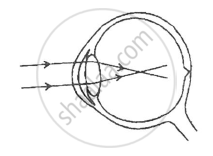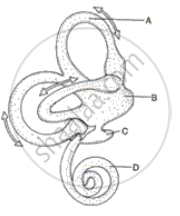Advertisements
Advertisements
प्रश्न
State the exact location of the Ciliary body
उत्तर
Between iris and choroid (composed of ciliary muscles)
APPEARS IN
संबंधित प्रश्न
Which part of our body helps us in maintaining the body balance?
Given below is a diagram depicting a defect of the human eye, study the same and then answer the questions that follow:

(i) Name the defect shown in the diagram.
(ii) What are the two possible that cause this defect?
(iii) Name the type of lens used to correct this defect.
(iv) With the help of a diagram show how the defect shown above is rectified using a suitable lens.
Given in the box below are a set of 14 biological terms. Of these, 12 can be paired into 6 matching pairs. Out of the six pairs, one has been done for you as an example.
Example : endosmosis - Turgid cell.
Identify the remaining five matching pairs :
| Cushing’s syndrome, Turgid cell, Iris, Free of rod and cone cells, Colour of eyes, Hypoglycemia, Active transport, Acrosome, Addison’s disease, Blind spot, Hyperglycemia, Spermatozoa, Endosmosis, Clotting of blood. |
A fluid that occupies the larger cavity of the eye ball behind the lens is
___________.
The ear ossicle which is attached to the tympanum.
State the main function of the Suspensory ligament of the eye
State whether the following statements are true (T) or false (F). If false, correct them by changing any one single word in each.
Semi-circular canals are concerned with static (positional) balance.
Name the three ear ossicles.
Name that part of ear which vibrates when outside sound falls on it.
There are three small bones in the muddle ear – anvil, hammer and stirrup :
(a) Which of these bones is in touch with ear-drum ?
(b) Which of these bones is in touch with oval window ?
Name the nerve which carries electrical impulses from the cochlea of ear to the brain.
The diagram alongside represents the structure found in the inner ear. Study the same and then answer the questions that follow:
(i) Name the parts labelled A, B, C and D.
(ii) Name the parts of the ear responsible for transmitting impulses to the brain.
(iii) Name the part labelled above which is responsible for:
1. Static equilibrium. 2. Dynamic equilibrium. 3. Hearing
(iv) Name the audio receptor cells which pick up vibrations.
(v) Name the fluid present in the inner ear.

The diagram alongside represents the structure of the human ear.
(i) Write the names of the parts labelled a to g.
(ii) State briefly the functions of the parts b, d, and g.
(iii) Name the main division of the ear.
(iv) Which is the smallest bone in the human body?
(v) What is labyrinth?

Choose the correct answer.
Labyrinth is a part of ____________
Choose the correct answer.
Canal joining middle ear to pharynx ___________
Draw a labeled diagram of the inner ear. Name the part of the inner ear that is responsible for static balance in human beings.
Mention, if the following statement is True or False
Cochlea of the ear is concerned with the sense of balance.
Given below is a diagrammatic representation of a part of the human ear.
- Name the parts numbered 1-6.
- Which parts of the ear shown here are complete.
 |
